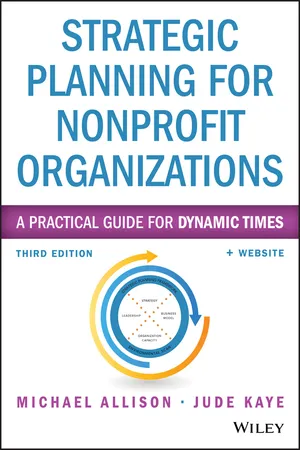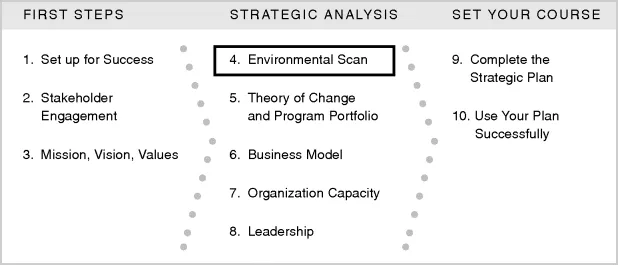
Strategic Planning for Nonprofit Organizations
A Practical Guide for Dynamic Times
- English
- ePUB (mobile friendly)
- Available on iOS & Android
Strategic Planning for Nonprofit Organizations
A Practical Guide for Dynamic Times
About this book
The bestselling guide to nonprofit planning, with proven, practical advice
Strategic Planning for Nonprofit Organizations describes a proven method for creating an effective, organized, actionable strategy, tailored to the unique needs of the nonprofit organization. Now in its third edition, this bestselling manual contains new information about the value of plans, specific guidance toward business planning, and additional information about the strategic plan document itself. Real-world case studies illustrate different planning and implementation scenarios and techniques, and the companion website offers templates, tools, and worksheets that streamline the process. The book provides expert insight, describing common misperceptions and pitfalls to avoid, helping readers craft a strategic plan that adheres to the core values of the organization.
A well-honed strategic plan helps nonprofit managers set priorities, and acquire and allocate the resources necessary to achieve their goals. It also provides a framework for handling challenges, and keeps the focus on the organization's priorities. Strategic Planning for Nonprofit Organizations is an excellent source of guidance for managers at nonprofits of every size and budget, helping readers to:
- Identify the reasons for planning, and gather information from internal and external stakeholders
- Assess the current situation accurately, and agree on priorities, mission, values, and vision
- Prioritize goals and objectives for the plan, and develop a detailed implementation strategy
- Evaluate and monitor a changing environment, updating roles, goals, and parameters as needed
Different organizations have different needs, processes, resources, and priorities. The one thing they have in common is the need for a no-nonsense approach to planning with practical guidance and a customizable framework. Strategic Planning for Nonprofit Organizations takes the fear out of planning, with expert guidance on the nonprofit's most vital management activity.
Frequently asked questions
- Essential is ideal for learners and professionals who enjoy exploring a wide range of subjects. Access the Essential Library with 800,000+ trusted titles and best-sellers across business, personal growth, and the humanities. Includes unlimited reading time and Standard Read Aloud voice.
- Complete: Perfect for advanced learners and researchers needing full, unrestricted access. Unlock 1.4M+ books across hundreds of subjects, including academic and specialized titles. The Complete Plan also includes advanced features like Premium Read Aloud and Research Assistant.
Please note we cannot support devices running on iOS 13 and Android 7 or earlier. Learn more about using the app.
Information
Section Two
Strategic Analysis

Chapter 4
Step 4: Environmental Scan

Table of contents
- Cover
- Praise for Strategic Planning for Nonprofit Organizations, Third Edition
- Title Page
- Copyright
- Dedication
- About the Third Edition
- Preface
- Acknowledgments
- Introduction
- Section One: First Steps
- Section Two: Strategic Analysis
- Section Three: Set Your Course
- Conclusion: A Word to Leaders
- Appendix A: Sample Workplans for Abbreviated, Moderate, and Extensive Planning Processes
- Appendix B: Tips on Using Task Forces
- Appendix C: External Stakeholders
- Appendix D: How to Use the Matrix Map
- Appendix E: Leadership Assessment Survey
- Appendix F: Selected References
- About the Companion Website
- About the Authors
- Index
- End User License Agreement